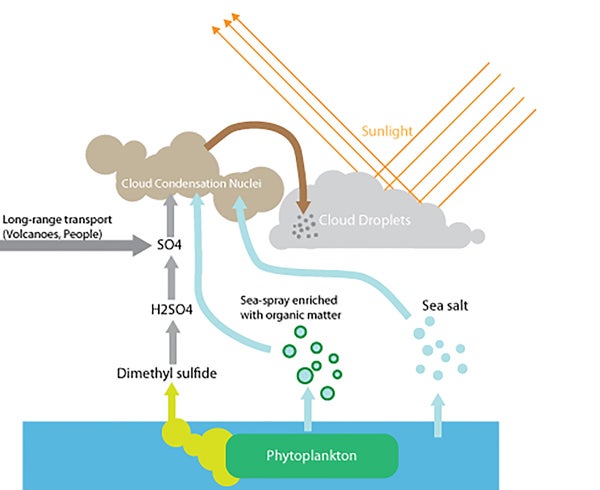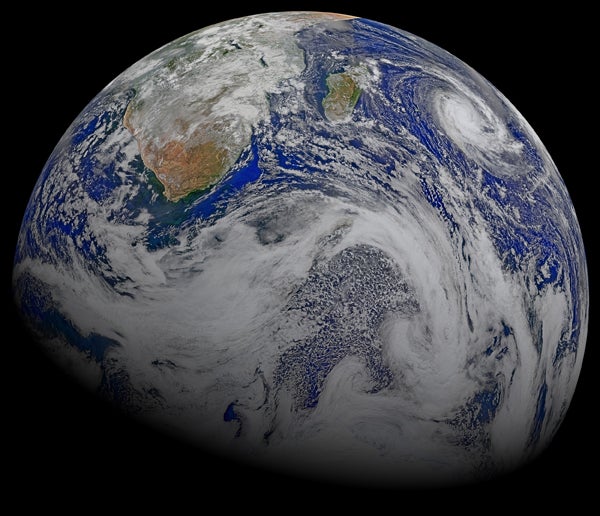The Southern Ocean has some of the thickest clouds on Earth, made brighter in the summertime by marine microbes living in the waters below, according to new research that combines satellite observations and computer modeling. In fact, bacteria and plankton drifting in the ocean produce particles that get whipped up into atmosphere where they seed cloud droplets, and in turn, the brighter clouds reflect more sunlight away from Earth.
"Life in the ocean increases the brightness of clouds and keeps the climate cooler than it would otherwise be," says Dennis Hartmann, an atmospheric scientist at the University of Washington (U.W.) who helped oversee the research published July 17 in the open-access journal Science Advances. "I was a little surprised how big an effect life has on cloud albedo in pristine areas of the oceans."
The more liquid that is suspended in a cloud, the more reflective it is, and ocean life seems to roughly double the number of water droplets forming in the sky, according to the study. It suggests that the brighter clouds reflect as much as 10 watts per square meter of sunshine in summer, which averages out to a reduction of four watts per square meter reaching the surface annually. That’s about as much sunlight as particulate matter from pollution reflects in other parts of the globe.
On supporting science journalism
If you're enjoying this article, consider supporting our award-winning journalism by subscribing. By purchasing a subscription you are helping to ensure the future of impactful stories about the discoveries and ideas shaping our world today.
The Southern Ocean is a forbidding place, especially to sailors, wracked by persistent winds and extreme weather. A current encircles Antarctica, locking it in deep freeze; it casts off whorls and eddies that swirl and mix vital nutrients in the seawater. When the sunlight shines on the region from spring until fall, an array of photosynthetic life-forms bloom in the water. "The return of light in the summer ignites an amazing flurry of activity in phytoplankton," says atmospheric scientist Daniel McCoy of U.W., who co-led the research with fellow atmospheric scientist Susannah Burrows of the Pacific Northwest National Laboratory.
Some bacteria and plankton pump out gases like dimethyl sulfide—the compound responsible for the unique smell of the sea—while also covering the surface of the ocean in an oily profusion of cells. Just like the salt in seawater, wind and waves loft these gases and plant and animal bits into the sky. Those particles—known as aerosols to scientists—become the centers for condensation of vapor in the atmosphere into the droplets that form clouds. In the Southern Ocean sea salt provides a constant source of cloudiness year-round, but in summer the marine microbes seem to enhance the process.

Courtesy of Daniel McCoy
The more droplets, the brighter a cloud and the better it is at reflecting sunlight. The view from satellites shows that regions with more phytoplankton have clouds with more, smaller droplets, McCoy notes. Marine blooms increase the number of cloud droplets by as much as 60 percent, and the brighter clouds come just when the most sunlight can be reflected, boosting the effect further. "Life in the ocean directly influences the brightness of clouds," Hartmann says.

Courtesy of NASA
Some people want to harness this process by spraying more droplets or aerosols into the air to create clouds and mitigate climate change—a geoengineering technique known as marine cloud brightening. But it appears that microbes may have got there first with a form of biological geoengineering.
At the same time, it remains unclear exactly how the biological aerosols change the chemistry of the atmosphere or whether they also boost the extent of cloud cover over the Southern Ocean. Understanding these factors might help elucidate exactly how sensitive Earth's climate might be to rising atmospheric concentrations of greenhouse gases like carbon dioxide, thanks to humanity's pyromania for fossil fuels. Nor is it clear that phytoplankton bloom or bust in response to cloudiness, forming a potential route for life to regulate climate, which has been suggested by some scientists. The correlation between marine life and clouds may also prove spurious, Burrows notes, but it is hard to explain the match between blooms and brighter clouds any other way. "Higher cloud droplet numbers occur over phytoplankton blooms, and we currently are unable to explain this phenomenon without invoking an increase in the [aerosols] near these blooms," she says.
"Life brightens the clouds, but we don't know how this might change as the ocean warms up," Hartmann adds. "We don't know if life will produce more or fewer cloud droplets in a warmed Earth." In other words, the tiny geoengineers may help human civilization with the global warming problem—or not.